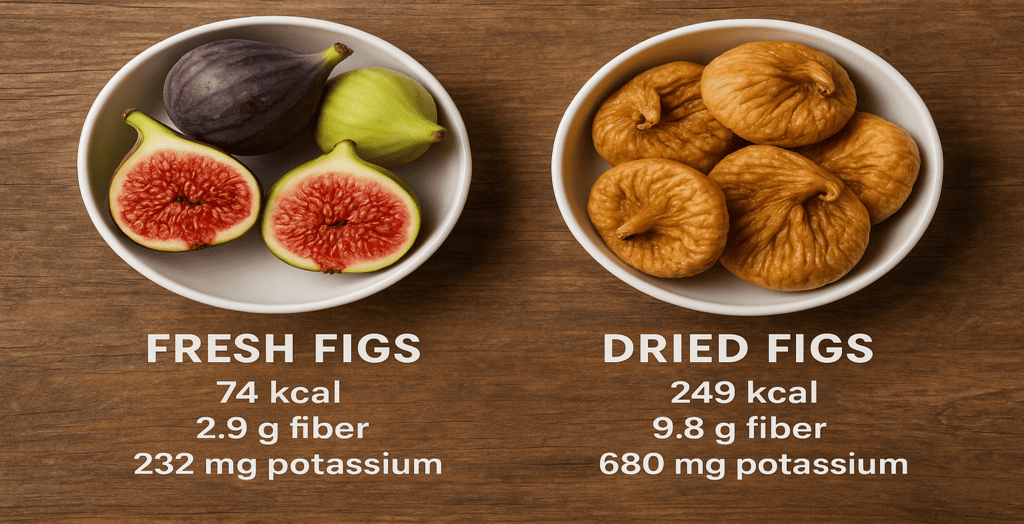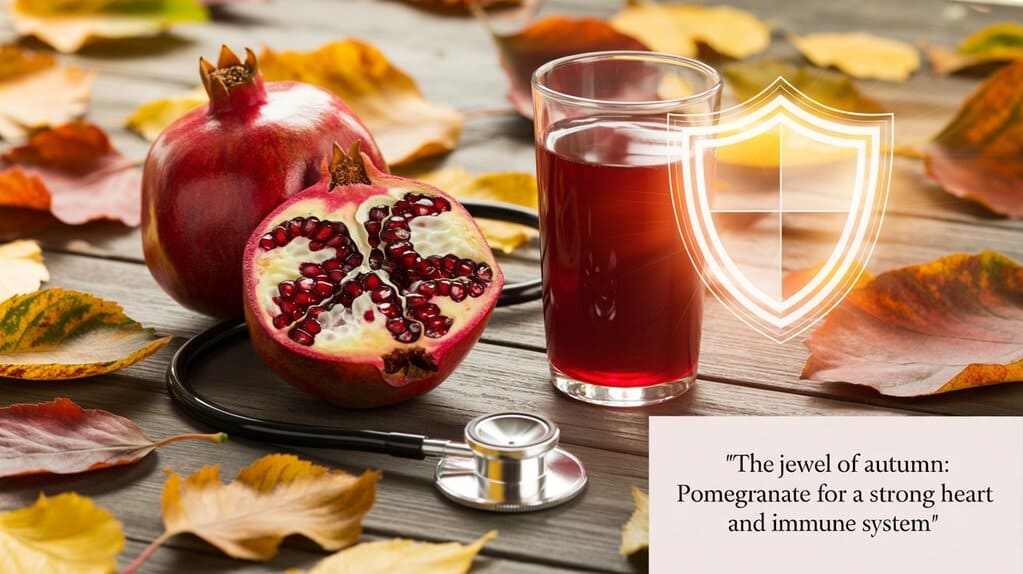
Introduction
Figs, both fresh and dried, are among the most nutritious and ancient fruits known to humankind. Native to the Mediterranean and Western Asia, figs (Ficus carica) have been cultivated for thousands of years. They are not only delicious but also packed with essential vitamins, minerals, fiber, and antioxidants, offering numerous health benefits. Their role in traditional medicine has been recognized in ancient cultures, and modern science continues to validate their remarkable properties.
Whether consumed fresh or dried, figs contribute to better digestive health, cardiovascular well-being, skin vitality, and blood sugar regulation. In this article, we delve into the scientifically backed advantages of incorporating figs into your diet, drawing from recent studies and expert insights.

Nutritional Profile of Figs
| Nutrient | Fresh Figs (per 100g) | Dried Figs (per 100g) |
|---|---|---|
| Calories | 74 kcal | 249 kcal |
| Fiber | 2.9 g | 9.8 g |
| Calcium | 35 mg | 162 mg |
| Potassium | 232 mg | 680 mg |
| Magnesium | 17 mg | 68 mg |
| Vitamin B6 | 0.1 mg | 0.5 mg |
| Iron | 0.4 mg | 2.0 mg |
| Antioxidants | Moderate | High |
Dried figs are more calorie-dense and nutrient-concentrated due to the water loss, making them ideal for quick energy and mineral intake, especially in active individuals.
1. Rich in Dietary Fiber
Both fresh and dried figs are excellent sources of dietary fiber, which supports:
- Healthy digestion
- Prevention of constipation
- Lower cholesterol levels
- Improved satiety and weight management
✅ Scientific Insight:
According to a study published in the journal Nutrients (2020), dietary fiber intake from fruits like figs is associated with a significantly reduced risk of colorectal cancer and metabolic disorders [Source: https://www.ncbi.nlm.nih.gov/pmc/articles/PMC7349634/].

2. Support Cardiovascular Health
Figs contain potassium, magnesium, and polyphenols that help in:
- Regulating blood pressure
- Improving arterial function
- Lowering bad LDL cholesterol
✅ Medical Study:
A 2021 clinical trial in the Journal of Hypertension found that consuming potassium-rich fruits like figs significantly lowered systolic blood pressure in adults with prehypertension.
“Potassium intake, particularly from plant-based sources such as dried fruits, plays a protective role against hypertension.” — Dr. Emma White, Cardiologist, University of London.
3. Control Blood Sugar Levels
While figs contain natural sugars, they also provide soluble fiber that slows down sugar absorption. Dried figs have a low to moderate glycemic index, making them suitable for diabetic patients when consumed in moderation.
✅ Research:
A 2022 article in Frontiers in Nutrition stated:
“Figs, especially when combined with nuts, have shown to blunt postprandial glucose spikes.”
[Source: https://www.frontiersin.org/articles/10.3389/fnut.2022.821694/full]
4. Strengthen Bones and Teeth
Figs are a natural source of calcium, phosphorus, and magnesium, essential for maintaining strong bones and preventing osteoporosis, especially in postmenopausal women.
| Bone Health Nutrients in Figs | Amount in Dried Figs (per 100g) |
|---|---|
| Calcium | 162 mg |
| Magnesium | 68 mg |
| Phosphorus | 67 mg |
5. Antioxidant and Anti-inflammatory Properties
Figs are rich in polyphenols, flavonoids, and vitamin C, which help:
- Combat oxidative stress
- Reduce inflammation
- Slow aging processes
- Protect against chronic diseases
✅ Expert View:
“Figs exhibit a high antioxidant activity, which could potentially protect cells from oxidative damage that contributes to aging and cancer.”
— Dr. Michael Greger, How Not to Die, based on various peer-reviewed research.

6. Support Skin Health and Anti-Aging
The antioxidants in figs, especially vitamin C and polyphenols, help maintain skin elasticity, prevent premature wrinkles, and promote collagen production.
Home Remedy:
A fig face mask made from mashed fresh figs and honey may help in:
- Moisturizing the skin
- Treating acne
- Enhancing glow
7. Enhance Sexual Vitality and Fertility
In many cultures, figs are considered a natural aphrodisiac. They are rich in zinc, magnesium, and amino acids, which are vital for:
- Boosting libido
- Improving reproductive health
- Enhancing stamina
✅ Scientific Reference:
An article in the Iranian Journal of Reproductive Medicine (2018) found that fig extracts improved sperm quality and libido in animal models.
8. Aid in Weight Management
Although dried figs are calorie-dense, they are highly satiating due to their fiber content. Including figs in a balanced diet can help prevent overeating and sugar cravings.
Pro tip: One or two dried figs with nuts make a perfect snack for those watching their weight.
9. Boost Immune Function
Figs provide a combination of vitamins A, C, E, and minerals like zinc and selenium that strengthen the body’s natural defense system.
- Help fight infections
- Aid in tissue repair
- Support recovery from illness
Comparing Fresh vs. Dried Figs
| Aspect | Fresh Figs | Dried Figs |
|---|---|---|
| Water Content | High | Low (Dehydrated) |
| Sugar Content | Lower | Higher (natural sugars concentrated) |
| Shelf Life | Short | Long |
| Usage | Salads, desserts, fresh snacks | Baking, snacking, energy bars |
| Fiber and Minerals | Moderate | High |
Precautions and Recommendations
While figs offer many health benefits, moderation is key:
- Excessive dried fig intake may cause bloating or diarrhea.
- People with diabetes should monitor their sugar intake.
- Fig latex (milky sap) may cause skin irritation in some individuals.
Pro Tip:
Soaking dried figs overnight enhances digestion and reduces sugar concentration for sensitive individuals.
Conclusion
Figs, whether fresh or dried, are truly a nutritional powerhouse. They offer a wide array of health benefits — from promoting heart and bone health to enhancing digestion, skin vitality, and even sexual wellness. Backed by modern research and traditional wisdom, figs deserve a place in your daily diet.
Including 2–3 figs a day can significantly contribute to your nutritional intake, helping you lead a healthier, more balanced life. So next time you’re choosing a snack, reach for a fig — nature’s own multivitamin.
References
- Wikipedia. Figs – General Information and Botanical Background.
- Greger M. (2015). How Not to Die. Flatiron Books.
- Nutrients Journal (2020). Dietary Fiber and Chronic Disease – PubMed Central
- Journal of Hypertension (2021). Fruit Potassium and Blood Pressure Control.
- Frontiers in Nutrition (2022). Glycemic Response to Fruit Intake.
- Iranian Journal of Reproductive Medicine (2018). Effects of Ficus carica on Reproductive Health.
- USDA FoodData Central – Figs, raw and dried






